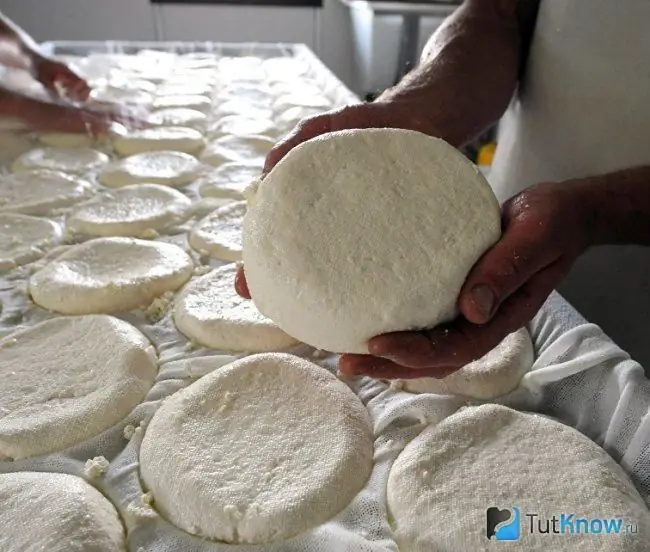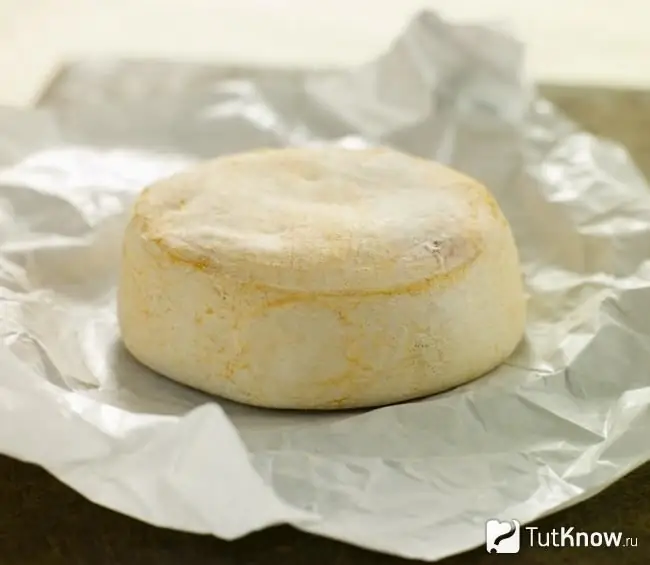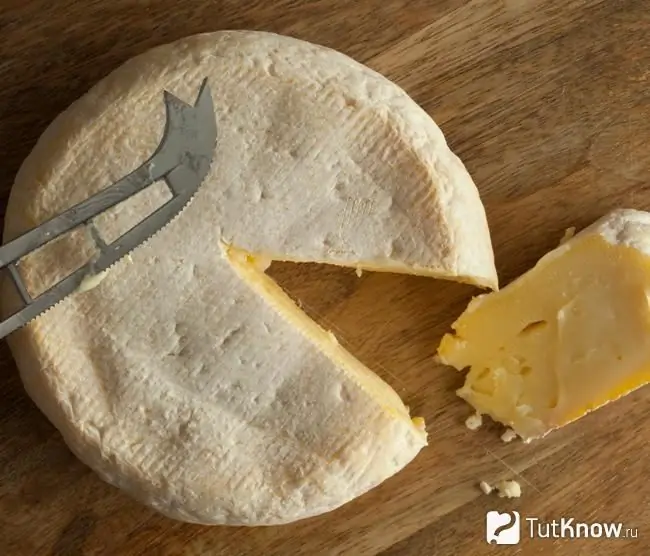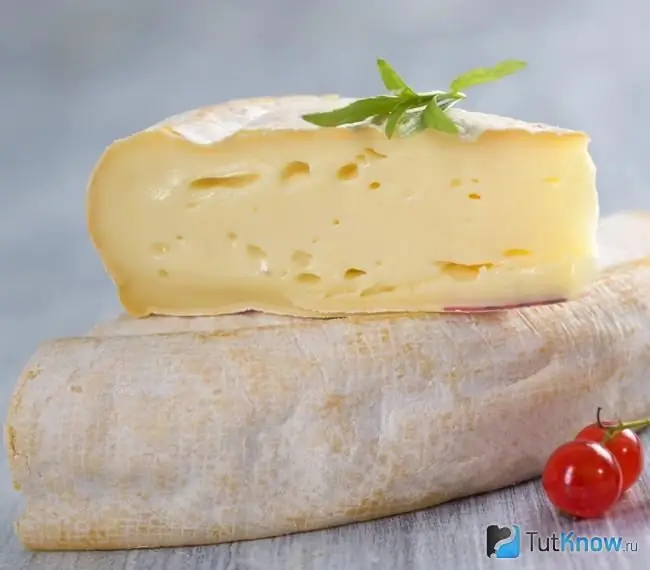- Author Arianna Cook [email protected].
- Public 2023-12-17 14:23.
- Last modified 2025-01-23 09:40.
How did Reblochon cheese come from? What is its use and what are the restrictions on its use? Recipes for dishes that the product complements especially harmoniously.
Reblochon is a soft cheese made from unpasteurized cow's milk. Standard heads have a diameter of 14 cm and a weight of 500 g, but recently special “tourist” versions have begun to be produced - small heads weighing about 250 g. The cheese is always sold in a round shape, has an orange crust covered with a white coating. The soft, fatty mass has a creamy texture and is colored in ivory. There are two types of cheese - peasant and fruit. True Reblochon has the prestigious AOC label, confirming its belonging to a certain geographical area and quality, it is produced in the French region of Savoie, located at the foot of the Alps. Only 184 settlements have the right to produce this type of cheese. In the rest of the world, few people try to repeat this delicacy. That is why it is so important, having the opportunity to taste the real Reblochon, not to deny yourself the pleasure of eating it in its pure form or as part of a particular dish.
Features of making Reblochon cheese

Reblochon is ranked among the so-called uncooked varieties, which means that milk is not pasteurized before cheese is made from it. Without pretreatment, it is mixed with ferments and other special ingredients, curdled, then crushed, laid out in molds, treated with saline and sent to ripening for 2-4 weeks.
With a few additional tools and components, you can get something very similar to the rare French cheese in your kitchen.
The recipe for Reblochon cheese is as follows:
- Heat milk to 30 degrees.
- Add starter culture (1/4 teaspoon) and culture powder (1/3 teaspoon) - these ingredients are easily ordered online today. Wait 5 minutes.
- Stir the milk gently and let it sit for another 15 minutes.
- Dilute calcium chloride (1/4 teaspoon) in room temperature water (50 ml), add to milk and wait half an hour.
- You will have a large curd curd and whey, cut the mass into 1 - 2 centimeters cubes.
- Put the milk on the fire again, now it needs to warm up to 35 degrees. As soon as the temperature reaches the desired mark, turn off the heat and leave the mass for 3-5 minutes.
- Now drain the whey, leave so much so that it rises slightly above the curd mass.
- Transfer the mass remaining in the pan into a cheese mold, tamping the grains well to form a head. Turn the head over to the other side every 30 minutes, the procedure must be done 4-5 times.
- Place the heads under the press overnight.
- In the morning, rub the head with salt (you need about 2 teaspoons).
- Transfer the cheese to a holding container and age at 8 degrees for 2-6 weeks. Turn the cheese regularly and wipe with a mild saline solution.
You can find out that the Reblochon cheese is ready by two signs: the crust has become sticky, and with a slight pressure on the center of the head, softness is felt.
You can store ready-made homemade Reblochon for 21 days in the refrigerator. For better preservation, the head must be wrapped in parchment paper.
Production Reblochon can have two marks. A green mark means that the cheese was made on a small farm using milk from cows in the same herd. Prepare "green" cheese immediately after milking from the freshest fresh milk. Since it has a temperature of 35 degrees, it is no longer heated. The red mark indicates that the head was prepared at an industrial cheese factory, having previously collected milk from cows from various farms. However, here it also does not "stale" and turns into cheese no later than a day after milking.
Composition and calorie content of Reblochon cheese

The calorie content of Reblochon cheese is 327 kcal per 100 grams, of which:
- Proteins - 19.7 g;
- Fat - 25.6 g;
- Carbohydrates - 2, 3 g.
The composition of the product is quite remarkable: if classic hard cheeses are equal in protein and fat content and do not have any carbohydrates in their composition, Reblochon has a clear preponderance towards fat components and is not deprived of carbohydrates.
It is also not deprived of nutrients useful for the body. It is rich in minerals such as potassium, calcium, zinc, copper. In addition, it contains many vitamins, primarily A, E and group B.
Useful properties of Reblochon cheese

The benefits of Reblochon cheese are determined by its vitamin and mineral composition. Let's consider the useful properties of each element in more detail:
- Potassium … Regulates the activity of the heart. This macronutrient improves the conduction of nerve impulses through neurons, on which the heart rate depends. In addition, the important role of the mineral in water-salt balance, protein production and oxygen supply to the brain is noted.
- Calcium … Strengthens bone tissue, and also has a beneficial effect on the structure of teeth and nails. In addition, this mineral regulates muscle contraction, which is why cramps are one of the symptoms of calcium deficiency or impaired absorption.
- Zinc … It is an immunostimulant and helps maintain the body's defense system "on alert". Also zinc is an active participant in collagen synthesis.
- Copper … It has a good anti-inflammatory effect. Also, the mineral has a good effect on the function of the thyroid gland and the digestive system.
- Vitamin A … The main vitamin of vision, it prevents ophthalmic diseases, especially those associated with long work at the computer - the so-called dry eye syndrome.
- B vitamins … They play an important role in the regulation of metabolic processes in the body, and also help the normal functioning of the nervous system.
- Vitamin E … One of the most powerful antioxidants. Antioxidants are special substances that resist free radicals, which in turn prevents the formation of abnormal molecular bonds, protecting the body from early aging and serious diseases, including neoplastic diseases.
It is also worth noting that the Reblochon cheese contains a full proteinbalanced in amino acid composition.
Interesting facts about Reblochon cheese

The name of the cheese comes from the word "reblocher", which translates as "re-milk the cow." This name was not given to him in vain, and it is associated with the legend of the origin of the product. In the 14th century, a tax was imposed on milk production for peasants, and special supervisors often came to the milking procedure. In their presence, the cows were not specially fed, and when the overseers left, they brought the matter to the end. From this second, usually more fatty milk, the peasants began to prepare Reblochon.
A true Reblochon with a quality mark is prepared only from the milk of three Alpine cows - abondance, tarentaise and monbéliard. At the moment, more than 48 thousand animals are involved in the production of gourmet cheese. About 6 million heads are produced annually.
During the production process, the cheese heads are washed with a saline solution, which contains brevibacteria, it is they who give the crust its typical orange color and a pronounced specific aroma. Unfortunately, sometimes manufacturers skip this step and tint the crust with natural dyes. This is not considered a violation of the technological process, but nevertheless, such a cheese loses in terms of organoleptic qualities, although its smell is more pleasant and understandable to the general public.
Reblochon cheese is prepared from May to October. At the beginning of the last month of spring, the cows are sent to free grazing in the mountains, along with the families of farmers. All summer they will live in specially equipped houses and work hard making delicious cheese. However, the start of a new cheese season in the Alps is always a celebration.
In August, in the small village of Cluzaz, the Reblochon festival is held, at which, of course, a huge signature dish is prepared - tartiflette. The festival features noisy dances and a beauty contest for cows.
Watch the video about Reblochon cheese:

Reblochon is a product for true gourmets, especially the farm variety. This cheese is made from unpasteurized milk and has a specific aroma and natural "animal" taste. Its versatility is perfectly emphasized by berry sauces and white wines. However, the exquisite Reblochon can also be used for "unexplored" purposes - cooking classic dishes (pasta, pizza, pies). However, you should not abuse cheese, in moderation it is very useful, but if you exceed the permissible limits, it can be harmful.






